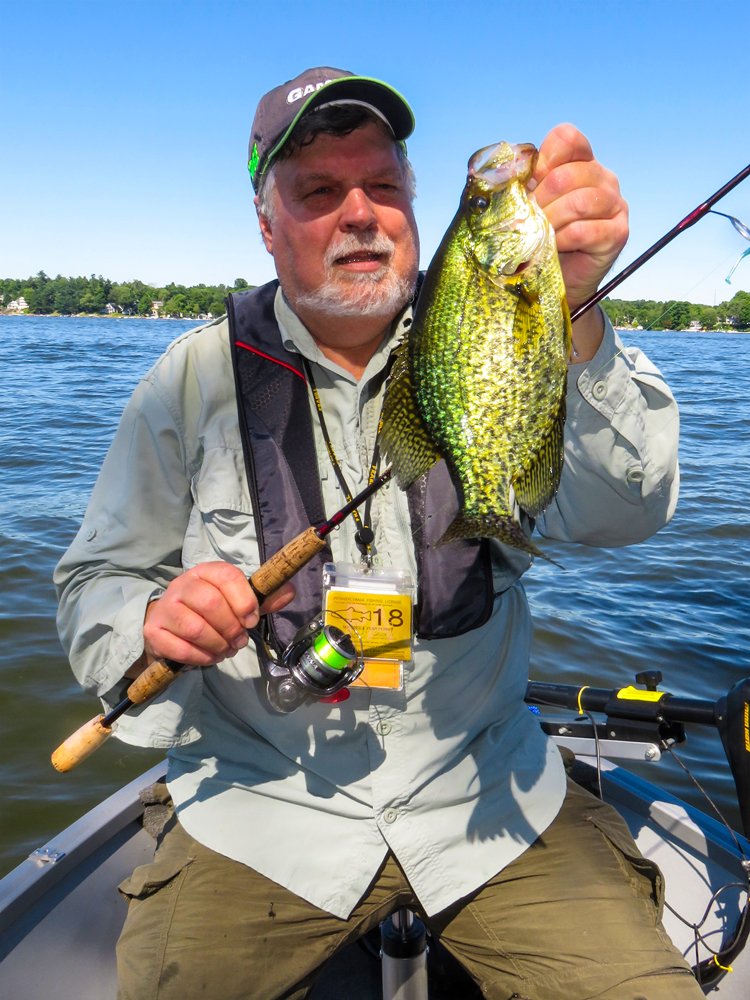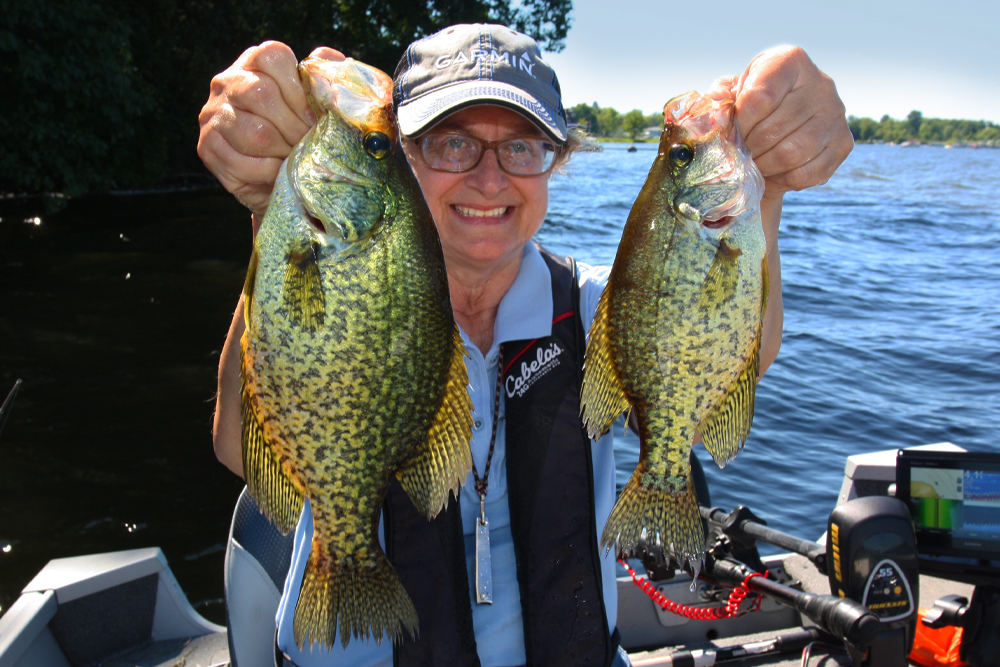Marilyn Black with a brace of crappies from Conneaut Lake. (Photo: Darl Black)
Summer Crappies on Northern Natural Lakes, by Darl Black
Go Natural in the Summer!
by Darl Black
Most northern natural lakes came into being during the Ice Age. Created by advancing and retreating glaciers, natural lakes dot the landscape from Minnesota across the Great Lakes states to New England. Some lakes are relatively shallow and bowl shaped, while others are much deeper with bottom areas of chunk rock and gravel. Regardless of shape and depth, practically all these lakes share two things: aquatic vegetation and a population of black crappie.
FIND THE WEEDLINES
In a northern natural lake, substantial numbers of crappies remain in or very close to deep vegetation all summer. Crappies do not migrate to creek channel ledges, stump fields or brushpiles on deep flats. The reason is simple – these structures do not exist on natural lakes.
Weedbeds may be on a shoreline flat or on an offshore hump. The depth to which vegetation grows depends on water clarity. In very clear water, the weedline may be nearly 20 feet deep. However, deep weed growth of 8 to 12 feet is more common. If the natural lake has a slight stain or a tannic color, the outside weedline edge will be shallower.

During the summer, crappies relate to submersed vegetation because weeds are the only form of “cover” on natural lakes and this is where crappies find an abundant source of small minnows and fry.
Submerged weed species vary from area to area, but may include native milfoil, coontail, cabbage (type of pondweed) and eel grass. But the exact species really does not matter. Rather, it is how the outside weed edge grows.
Generally, the more attractive areas for crappies during the summer are sections where the weed edge is ragged or less defined. Flatter slopes with sporadic weed clumps or a broken weed wall usually hold more crappies than a weed section with an abrupt edge. Now that’s not to say crappies absolutely avoid sharply defined weed walls; other factors can draw them to a vertical weed wall.
If you have the latest real-time forward scanning sonar, you may be able to pick out groups of crappies that are in the weed fringe on your screen. But few crappie fishermen in my neck of the woods have the pricey Livescope and its accouterments. I don’t. Instead, I find my crappies the old-fashioned way – I fish for them.
My home lake is 125-acre Conneaut Lake in northwestern Pennsylvania – maximum depth of 70 feet with a summer thermocline a tad shallower than 30 feet. Weedbeds ring the entire lake. Over the years, I have found roughly 18 sections of deep weeds on flats and humps which hold summer time crappies.
PRESENTATION MATTERS
My experiences on Conneaut help me to identify likely crappie summer areas on other natural lakes I visit in New York. But I still need to experiment with presentations to figure out exactly where the crappies are on a given day and to determine their mood. Active fish may be on the outside weed edge or slightly further from the weeds into open water. They may be chasing minnows over the submersed weeds. Or they may be buried in the weedbed, requiring a presentation to tease them upward to take a bait.
Therefore, I’ll have three light action 6.5 to 7-foot spinning rods on the deck; two are spooled with 4-pound Gamma Panfish line and one with 6-pound Gamma. One rod is rigged with a Bobby Garland Swimming Minnow on a 1/8-ounce Road Runner Head or an ordinary ball head jig. Another rod has a Charlie Brewer Crappie Slider Grub rigged weedless on a 1/16-ounce Crappie Slider Head.
The 1/8-ounce bait is used to probe the outside edge of the vegetation. Casts are made parallel to the deep weed edge, allowing each succeeding cast to sink a little deeper before beginning the retrieve. Casts will also be directed to slightly deeper open water in case crappies are sunning a shiner school in open water in the early morning.
The 1/16-ounce Weedless Crappie Slider is fan casted over the submersed weeds. The weedless rigging keeps most floating strands of grass from collecting on the hook. A steady retrieve is just fast enough to keep the bait from sinking into the thick growth. Feeding fish will run down the bait.
The final rod with the six-pound test line has a Bobby Garland Baby Shad on a 1/32-ounce jighead suspended below a casting float. The bobber may be a Plastilite Oval Float, a Thill Foam Oval Weighted Float or an A-Just-A-Bubble. The depth setting of the Baby Shad will be based on the distance between the surface and the tops of the submersed weeds.
This is the outfit for those tough days when crappies are not aggressive, such as mid-day bright sun and no breeze. These crappies require some teasing. Utilizing a bobber to support the small bait allows an exceptionally slow retrieve with intermittent pauses. That stop and go retrieve is the best way to draw them up from their weedy hideout.
(Darl Black has been fishing since he was old enough to pick up a fishing rod. He penned his first angling article in the mid-1970s on a now-extinct writing device called a typewriter. During his career as an outdoor writer and photographer, Darl has fished throughout the US and Canada for many freshwater species but still enjoys fishing for crappies.)


